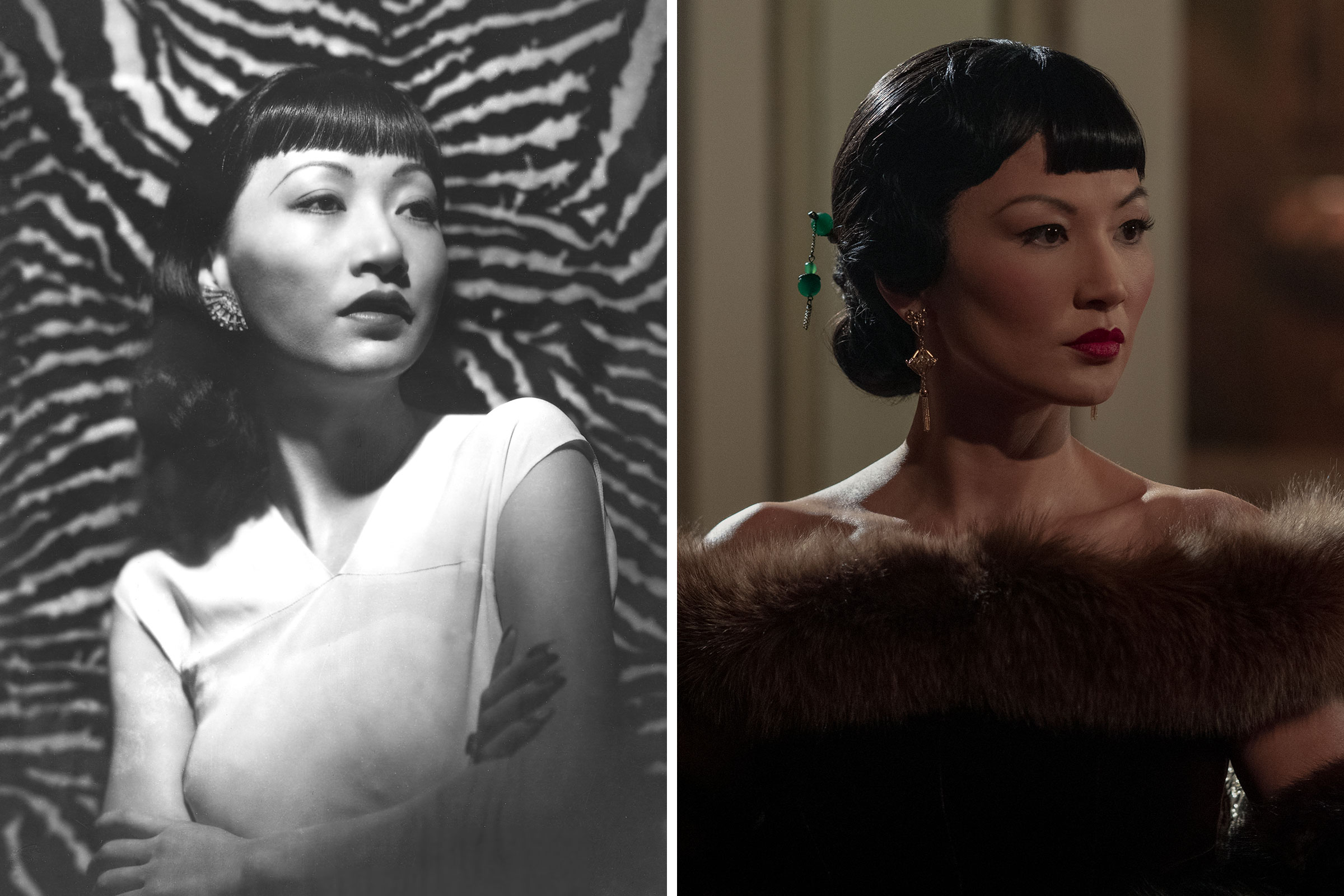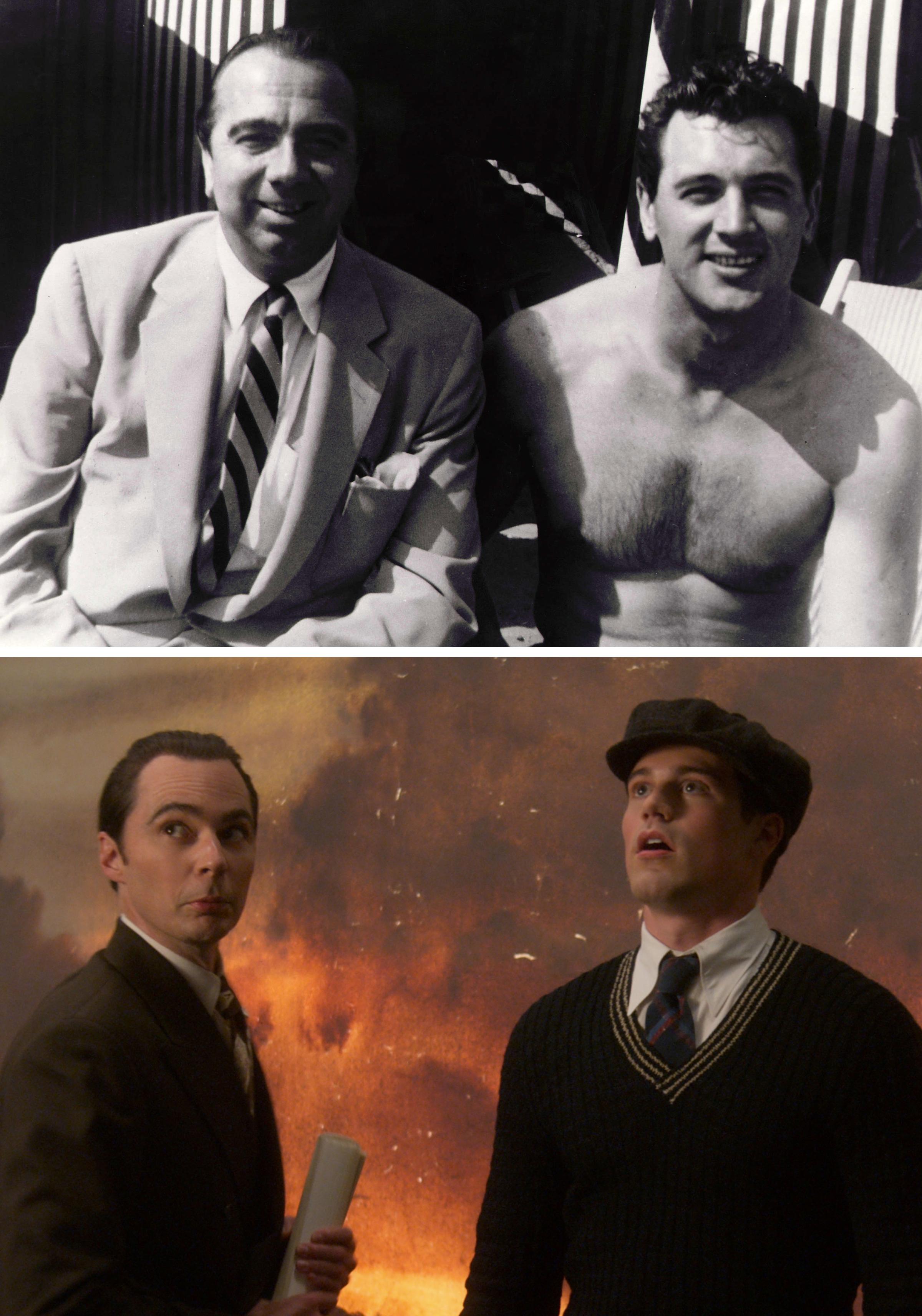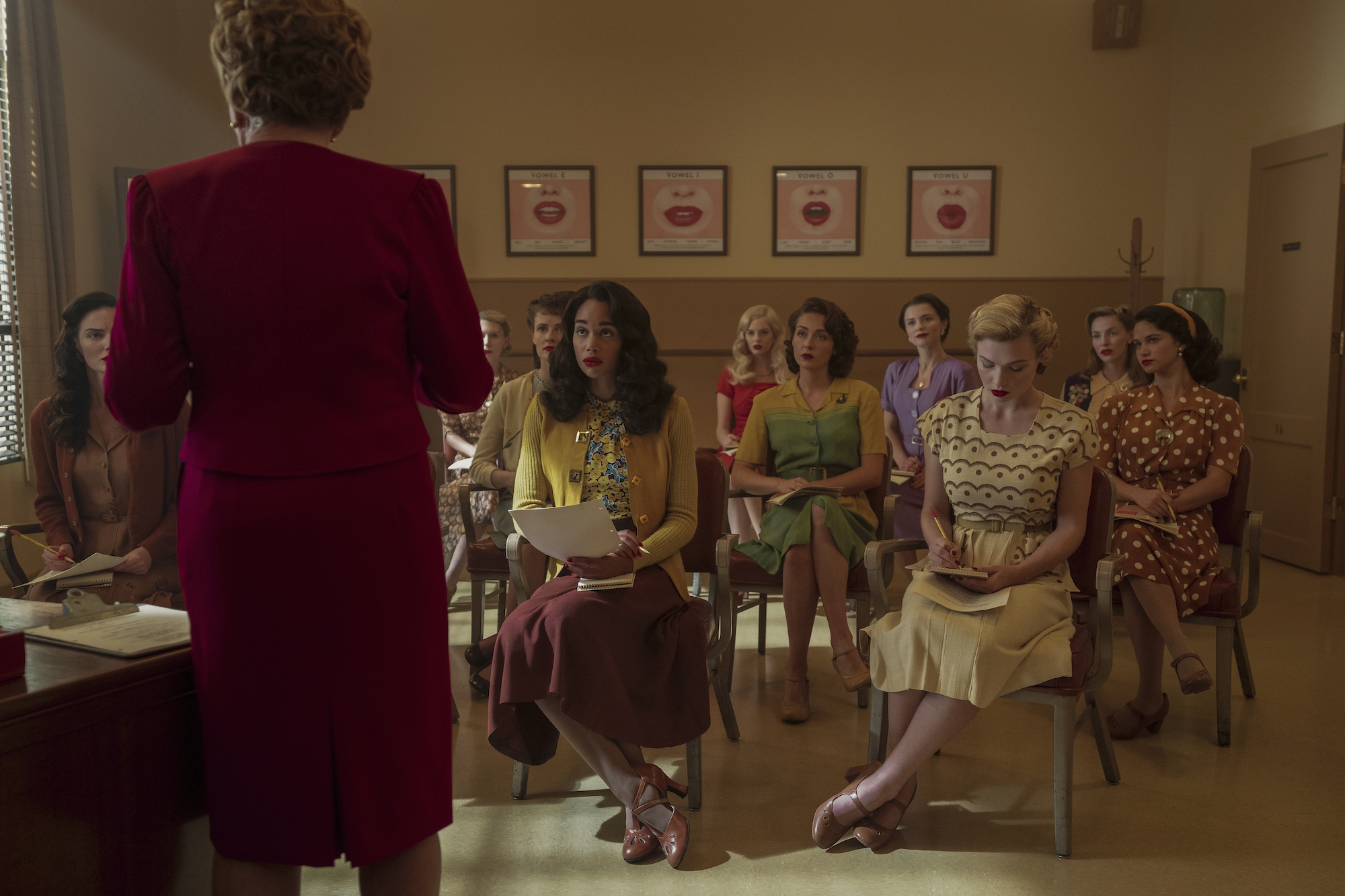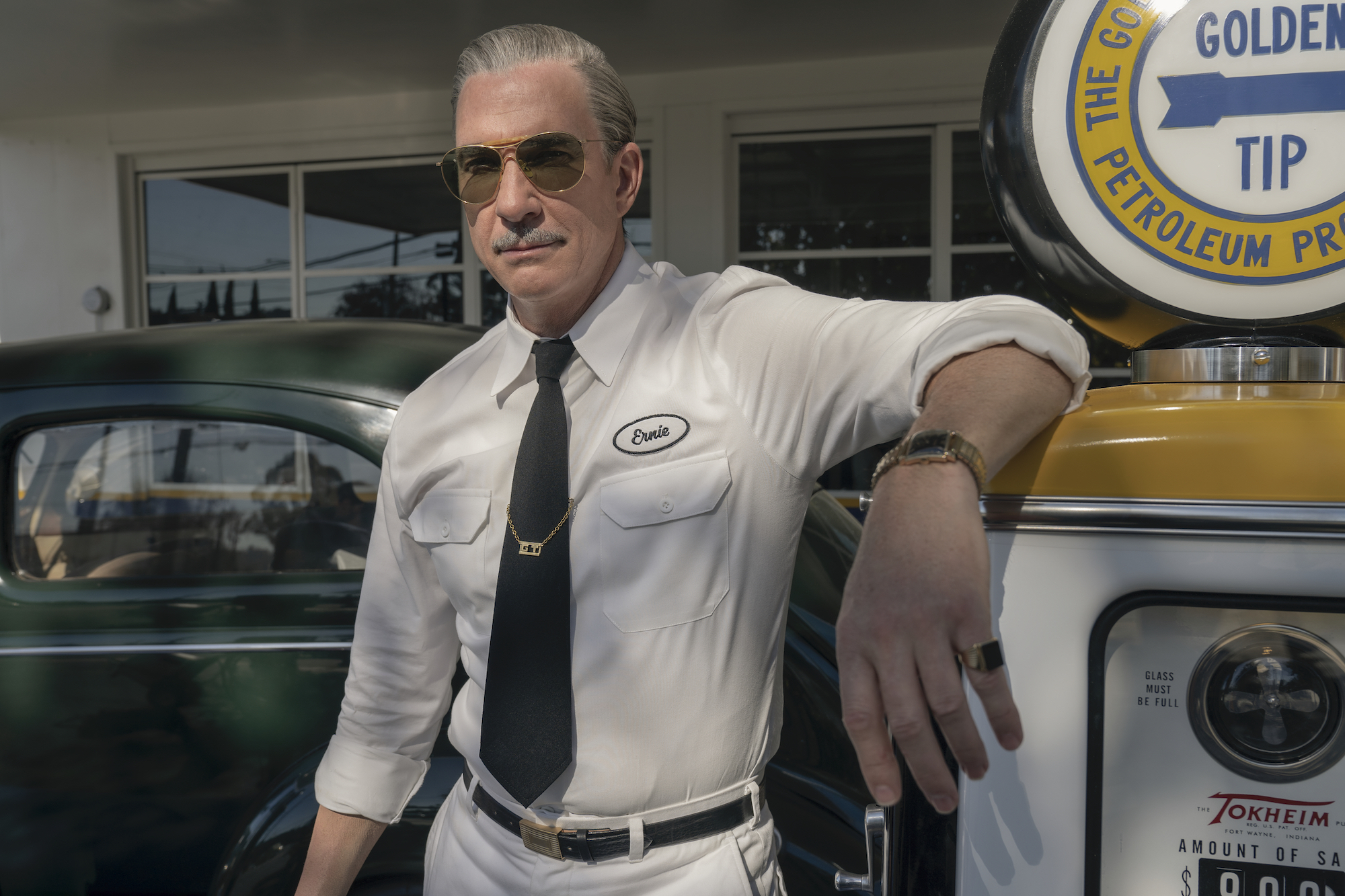In Ryan Murphy‘s new Netflix limited series Hollywood, post-war Tinseltown is reenvisioned with an imaginative “what if?” approach.
The show tells a fictional narrative about a group of actors and filmmakers trying to break into the industry following the end of World War II. While characters like Darren Criss’ director Raymond Ainsley and David Corenswet’s actor Jack Costello are not based in history, much of the story is drawn from or inspired by real people—including heartthrob Rock Hudson and Oscar winner Hattie McDaniel—and events from the golden age of Hollywood.
“I wanted to do something where I gave some, if not all of these people a happy ending,” Murphy tells TIME. “How do I make a commentary on the power of Hollywood to change hearts and minds? I decided to put together a fictional alternative-universe Hollywood and then populated it with some real people, and other fictional characters loosely based on real people.”
Below, read about the aspects of Hollywood based in history.
Anna May Wong

When viewers first encounter Anna May Wong (played by Michelle Krusiec) in Hollywood, she tells Criss’ director Raymond Ainsley that audiences “don’t want a leading lady that looks like me.”
“My entire career: oversexed, opium-addled courtesans; dangerously exotic Far Eastern temptresses—that’s what they wanted to see from someone who looks like me,” she says.
In real life, Anna May Wong was also extremely vocal about the discrimination she experienced as the first Chinese-American star in Hollywood. Wong found fame in silent movies during the 1920s, but she also found herself sidelined by the racist structures in place in her industry and beyond.
“The Anna May Wong story is one of the most shocking stories in Hollywood history, and so many people don’t know about her,” Murphy says. “Here was a woman who was clearly an incredibly beautiful and talented movie star, who was relegated to these sidekick roles even though she had shown that she had great talent and range.”
Due to the miscegenation laws that prevented even the suggestion of interracial relationships onscreen, Wong was often cast as dragon ladies, villains or submissive slave girls or servants, while lead roles went to white actresses in yellowface. The most egregious of these instances was when Wong was passed up for the role of O-Lan in The Good Earth, despite an excellent screen test and, crucially, being the only Chinese-American actress in Hollywood at the time. The role went to Luise Rainer, who won her second consecutive Oscar for her performance.
“She was significant in that she was actually outspoken in the time when there weren’t any roles for her,” says sociologist Nancy Wang Yuen, the author of Reel Inequality: Hollywood Actors and Racism. “People can look back on her roles and might think, ‘Oh, she played into stereotypes,’ but those were really the only roles possible.” As for The Good Earth, Yuen explains that even though the characters in the film were Chinese, “They had already cast Paul Muni, and because he was a white actor, there couldn’t be any insinuations of any romantic relationships.”
In Hollywood, Wong gets an opportunity to take a role that doesn’t play into stereotypes. In reality, she set off for Europe in 1928, where she became the first international Asian-American star, acting in films and plays and hosting her own cabaret. In the 1950s, she became the first Asian-American actor to be the lead in a U.S. TV series, The Gallery of Madame Liu-Tsong.
The show’s revisionist history draws a stark contrast to the reality that there’s still much more work to be done when it comes representation in Hollywood. To date, no Asian-American actress has won an Academy award in a lead acting category, and roles intended for Asian actors continue to go to white actors.
“Asian Americans in particular, we are an invisible minority,” Krusiec tells TIME. She adds that the alternate universe of Hollywood gives Wong, in a way, a chance to been seen for the leading lady she could have been. “[Playing her] was this journey of her really being seen and being given a chance to have her wrongs righted.”
Hattie McDaniel

“Just think, what would Hattie McDaniel do?” Camille Washington, an aspiring actress played by Laura Harrier, is told while shooting a scene in which she plays a housemaid. Camille nods and redoes the scene in a caricatured, high-pitched voice, pleasing the studio heads.
In 1940, McDaniel became the first African-American actor to win an Oscar, for her role as Mammy, a housemaid and former slave, in Gone with the Wind. House servants, cooks and maids were often the only kinds of parts available to African-American actors, and over the course of her career, McDaniel took on more than 70 such roles. In Hollywood, Camille faces this obstacle herself. “That’s a white role, honey,” she’s told when she inquires about a more substantial part in a crime drama.
Though she was able to build a career and make a name for herself, McDaniel was also subject to criticism, from the National Association for the Advancement of Colored People and others, for perpetuating negative stereotypes. McDaniel disagreed with their assessment. “I have never apologized for the roles I play,” she wrote in The Hollywood Reporter. “Several times I have persuaded the directors to omit dialect from modern pictures. They readily agreed to the suggestion. I have been told that I have kept alive the stereotype of the Negro servant in the minds of theatre-goers. I believe my critics think the public more naïve than it actually is.”
Murphy says he is fascinated by McDaniel’s story “because it is equal parts triumph and tragedy. She was the daughter of a slave and she did make a wonderful living and win an Academy Award, but she was also denigrated and she wasn’t given other opportunities.”
Later in the series, McDaniel comes to life in Murphy’s fictional Hollywood, played by Queen Latifah. She becomes a mentor to Camille, a newcomer to an industry rife with racism, and tells her not to let anybody shame her. She also shares her experience of being barred from the hall where the Oscar ceremony took place the year she won, because the venue had a “no colored” policy. This much is authentic to historical events: the 12th Academy Awards were held at The Ambassador Hotel, which had just such a policy. A special favor had to be called in for McDaniel to be allowed in the building at all, and once she was, she was seated at a small table far from the action.
Camille Washington

Camille Washington, played by Laura Harrier, is a fictional character inspired by Lena Horne and Dorothy Dandridge, according to Murphy.
“[Camille] was loosely based on their struggle,” he says. “They were beautiful and incredibly talented, more talented than many of the actresses who were getting great opportunities, like Lana Turner, and yet they just could not get beyond a certain level.”
In Murphy’s fictional world, Camille gets the opportunity to play a leading role—though not without having to fight for it first. This plotline, Murphy says, imagines what it might have looked like if Dandridge and Horne had received more opportunities early in their careers.
Though Dandrige and Horne were considered trailblazers, both struggled to win quality parts for much of their careers. Horne, who was under contract at MGM Studios, had little opportunity outside of roles in “race movies,” films targeted at African-American audiences, and musical numbers which were cut from films when they played in the South. Dandridge appeared in a number of uncredited roles, but eventually played the lead in Bright Road (1953) and then Carmen Jones (1954), for which she became the first African American to earn an Oscar nomination for Best Actress. (She lost to Grace Kelly for her performance in The Country Girl.)
Hollywood’s happier ending for Camille epitomizes what Criss’ character, Raymond, wishes studio executives would realize: “Movies don’t just show us how the world is, they show us how the world can be.”
Henry Willson and Rock Hudson

Rock Hudson was one of the most sought-after leading men during the 1950s and 1960s, playing opposite stars like Doris Day, Elizabeth Taylor and Lauren Bacall. But he spent the majority of his career and his life in the closet. Hudson, who was born Roy Scherer, Jr. in Winnetka, Ill., kept his personal life under wraps due to the intense homophobia in both the industry and the world at the time.
“Long before he landed in Hollywood, he understood that if he wanted to be accepted, the very essence of who he was would have to be edited out of the frame,” writes Mark Griffin in All That Heaven Allows, a biography of Hudson.
Hudson, who made more than 60 films during his career, was extremely private about his personal affairs. He had a short-lived marriage with his agent’s secretary in 1955 to quell rumors about his sexuality. In 1985, at the age of 59, he became the first major celebrity to go public with an AIDS diagnosis, which brought worldwide attention to the disease. He died just a few months later.
For Murphy, the decision to include Hudson as a storyline in Hollywood was deeply personal. The revisionist portrayal of the show gives the actor (played by Jake Picking) the chance to come out at the start of his career, which he does by holding his boyfriend’s hand on a red carpet.
“In order to get that success in Hollywood, to get those romantic comedies with Doris Day, he literally had to live a lie,” Murphy tells TIME. “I think people in the industry like Elizabeth Taylor and Claudette Colbert, people who were his friends certainly knew he was gay, but he definitely had to live a lie. I was interested in, what if Rock Hudson was rewarded and not punished for being who he was?”
While much of the show reimagines what life would be like for Hudson as an out gay man, there’s also a darker storyline drawn from Hudson’s real-life experience. In the show, the actor is encouraged to hide his sexuality by his controlling and predatory talent agent, Henry Willson (Jim Parsons), who uses their professional relationship to sexually abuse Hudson.
In real life, Willson—who was credited with starting Hollywood’s “beefcake” craze of brawny, hyper-masculine men—was known for both his shady dealings and star-making prowess as a talent agent. (In addition to making Hudson a household name, he was also responsible for launching the careers of Lana Turner, Troy Donahue, Rory Calhoun and others.) It was an open secret in Hollywood that Willson was gay and that he had his own version of the “casting couch” for many of his clients.
“Henry Willson was sort of the original Harvey Weinstein, in many ways, just an absolute monster,” Murphy says. “Rock Hudson, by the way, tried desperately for 20 years to get away from Henry Willson, and it was very hard for him because Henry Willson was very close to a lot of studio executives and also people in the mob. So not only do you fear for your work, you feel like you’re going to be killed.”
The Mid-Atlantic Accent

If you’ve ever watched an old Hollywood movie, and certainly almost anything starring Katharine Hepburn, and thought, wait, why are they talking like that?, a scene of an elocution class at Ace Studios in Hollywood‘s second episode has the answer.
“It’s not I have a ‘doody.’ It’s duty. Liquid ‘u.’ And the article ‘a’ is pronounced ‘ah,’” studio exec Ellen Kincaid, played by Holland Taylor, teaches the class. Then, she asks where the mid-Atlantic accent comes from.
“The middle of the Atlantic,” responds Claire Wood (Samara Weaving).
“And who lives in the middle of the Atlantic?” Kincaid follows up.
“No one,” Camille chimes in.
Kincaid goes on to explain that the Mid-Atlantic accent is made-up. “No one actually speaks this way naturally, but it takes on some British inflections that add some refinement to the otherwise flat and grating American dialect. You ladies will do very well to speak in this dialect at all times.”
Though the accent is not an organic one, it was widely used by the American upper class. Also called the Transatlantic accent, it was a middle ground between British and American accents. It required speakers to drop the “r” when it was the last letter of any word (“mister” would become “mistah”), emphasize “t’s” and lose any harsh vowels (“ah” rather than “a,” as Kincaid instructs). It was often taught to students in elocution classes at private schools and became a posh way of speaking associated with the well-off, who used it to come across as sophisticated and worldly. It can also be heard in Franklin Delano Roosevelt’s fireside chats.
Mid-Atlantic was officially codified by linguist Edith Skinner in her 1942 book Speak With Distinction. From then on, it was the dialect of choice for Hollywood. But the accent eventually dwindled, as the American middle class grew, and a new wave of directors like Francis Ford Coppola and John Cassavetes set out to make films that were more grounded in the realities of that middle-class life.
Ernie’s Gas Station

“The gas station was the portal that eventually took me into an exclusive world where high-class sex was everything,” wrote Scotty Bowers in his memoir, Full Service: My Adventures in Hollywood and the Secret Sex Lives of the Stars. Bowers, who called himself a “fixer,” was likely Murphy’s inspiration for Dylan McDermott’s character, Ernie.
In the show, Ernie recruits good-looking Hollywood outcasts trying to make it big to work at his gas station. But when a customer rolls up, more than likely in a luxury car, and utters, “I want to go to Dreamland,” it’s more than just gas the workers will have to serve up to the A-list clientele.
In real life, Bowers moved to Los Angeles after serving in the war and ended up working at a Richfield Oil gas station on Hollywood Boulevard. One day, Canadian actor Walter Pidgeon drove up to the station and asked Bowers, “What are you doing for the rest of the day?” Thus began Bowers’ role as Hollywood’s pimp.
Commonly referred to as “Mr. Sex,” Bowers developed a network of sex workers, and Pidgeon helped spread the word. Bowers claimed to have set up trysts for a number of A-list celebrities, including Cary Grant, Katharine Hepburn, Bette Davis and Randolph Scott, and even arranged orgies for Cole Porter, who is depicted as a customer in Hollywood‘s first episode.
Bowers, who died in 2019, would end up playing a crucial role in the LGBTQ community. At a time where actors had to abide by morality clauses, gay sex was illegal and queer people were shunned by society, Bowers helped stars live out their sexual identities while keeping the encounters confidential. In 2018, West Hollywood honored Bowers by presenting him with a proclamation recognizing his contributions to LGBTQ history.
Peg Entwistle

In Hollywood, writer Archie Coleman (Jeremy Pope) bases his screenplay Peg on the real-life story of Peg Entwistle, the aspiring British-born actress who made headlines for jumping to her death off the “H” in the then-Hollywoodland sign in 1932. Coleman, a black screenwriter, explains that his rationale for centering his screenplay on Peg, a white woman, is that he can identify with her fears of never being able to break into an exclusive film industry.
Born Millicent Lilian Entwistle, the actress found success on Broadway in the 1920s and ’30s (according to the BBC, so much so that Bette Davis cited her as one of her acting inspirations). Entwistle decided to move to Los Angeles in the hopes of becoming a movie star, but the film industry proved much more difficult to break into than the stage had been. When Entwistle finally landed a role in David O. Selznick’s Thirteen Women, she believed it would change her luck.
But because Entwistle’s part had a lesbian subtext, it was mostly cut from the final film after previews when the moralistic Hays code deemed the storyline offensive, a devastating professional blow from which she never recovered.
Entwistle reportedly fell into a depression and began drinking, before taking her own life by climbing the maintenance ladder on the “H” of the famed sign and jumping to her death. The following day, a hiker found her body, along with her shoe, a jacket and her purse, which contained a suicide note that read: “I am afraid, I am a coward. I am sorry for everything. If I had done this a long time ago, it would have saved a lot of pain. P.E.”
“She was a really hard worker, she finally got a part in a movie, and it was going to hopefully lead to other roles,” says Murphy. But when that didn’t happen, she became “that cautionary tale, that person that Hollywood ate up and spit out, this victim who couldn’t take it anymore.”
More Must-Reads from TIME
- Cybersecurity Experts Are Sounding the Alarm on DOGE
- Meet the 2025 Women of the Year
- The Harsh Truth About Disability Inclusion
- Why Do More Young Adults Have Cancer?
- Colman Domingo Leads With Radical Love
- How to Get Better at Doing Things Alone
- Michelle Zauner Stares Down the Darkness
Write to Cady Lang at cady.lang@timemagazine.com and Anna Purna Kambhampaty at Anna.kambhampaty@time.com